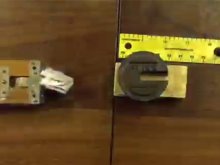
As part of the GCSE Physics syllabus, pupils are required to explore momentum in vehicles and the dynamics of crashing. This week, students were asked to investigate crumple zones, and how they serve to improve vehicle safety. To aid their investigation, Year 11 pupil Conor Crow recorded the trials slow-motion, to closely analyse what happens upon impact with a stationary object.
Pupils experimented with changing the design of a crumple zone on a dynamics trolley, which was driven into a stationary mass. After each trial, the group investigated how their crumple zone reduced the impact forces as the momentum was lost from the moving cart. This was related to two case study videos of a newer and older car being crash-tested for real.
Physics teacher Mr Nick Sexton explained: ‘Crash-testing has evolved considerably in recent years, as road safety continues to improve. Car manufacturers use the latest technology to make crashing safer, which requires a strong understanding of the laws of physics! Using the slow-motion capture of a mobile phone enabled pupils to see how the trolley came to a halt as well as seeing their crumple zone compressing gradually over a very short timescale. This then helped the pupils to relate the collision to their measurements of the debris afterward.’
The Apple Slowmotion feature takes split-second pictures and merges them into a frame-by-frame video. Conor Crowe took care of the filming, and analysed the clips along with his classmates Joe Sung, Henry Atkinson, Oscar Fagerstrom-Day and George Cowley.
Their video clips can be viewed below:





















